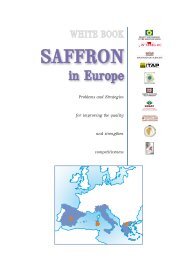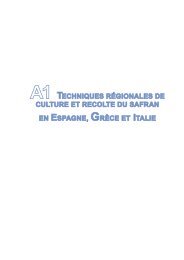Annex White book.pdf
Annex White book.pdf
Annex White book.pdf
Create successful ePaper yourself
Turn your PDF publications into a flip-book with our unique Google optimized e-Paper software.
should be controlled and should be found neutral. The dye substancesare separated from the column with 5 ml of methanol / ammonium solutionat 25 % (95/5) and placed in a bottle. The dissolvent is evaporatedat room temperature in a rotating evaporator. The remaining is dissolvedin 500 μl of methanol. The sample is then analyzed through HPLC andUV-Vis detector of variable wavelength. The type of the chromatographictube is C18. It is 25 cm long and has a diameter of 4 mm. The size ofthe static phase particles is 5 μm and the pore diameter is 100 Å. Theare two separation solvents: the first is a regulative solution A (aqueoussolution with 4,5 pH, containing 0,001 mol/L of tetra-n-butylammoniumhydrogen sulphide and 0,001 mol/L of potassium dihydrogenesulphate)with acetonitrile. The second is a regulative solution B (aqueous solutionwith 4,5 pH, containing 0,0014 mol/L of tetra-n-butylammonium hydrogensulphide and 0,0014 mol/L of potassium dihydrogenesulphate) withacetonitrile. The analysis is carried out in order to detect dye substancesand can take place by two different methods. In the first method, we placea 20 μL of sample in constant elution with the first solvent. In the secondmethod we use also 20 μL of the sample but the elution takes placegradually: 100% of the first solvent for 14 minutes and then 100% of thesecond solvent for 10 more minutes. The quantitative and qualitativedetection of artificial dye substances is possible through HPLC, providedthat the same analysis has taken place with clear artificial dyes in differentconcentrations in order to obtain the reference curves.A4.3.2.2. Soon developed ISO techniqueThe principle of this future method (that has recently been approved) isbased on the extraction of dye substances with warm water and the eliminationof the natural saffron dyes (crocetine esters) through acid treatmentand successive washings. The dyes are separated and isolated throughchromatography in a polyamide microtube. The identification takes placethrough HPLC in reverse phase through diode array detector. Apart fromthe dye substances described by the ISO/TS 3632:2003 a few more wereincluded: naphtanol yellow, 2G red, 2G yellow and melted red.Dye substances extraction:500 mg of saffron powder are placed in centrifugal tube. We add25 ml of water at 60oC and stir by hand for 1 minute. All particles ifthe saffron powder should swim in the water. We leave the solution torest for 10 minutes, unexposed to light and then stir again vividly. Thetube is centrifuged at 4000 rounds per minute for 10 minutes and thesupernatant is placed in a sediment glass container using a Pasteurdropper. We add 500 μl of formic acid at 98% or 2,5 ml of cold aceticacid in order to raise the pH at about 2.163




